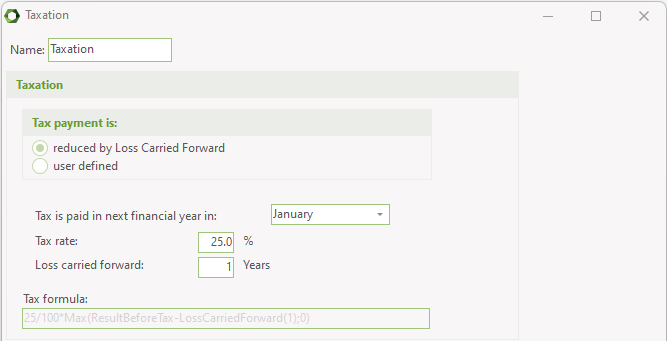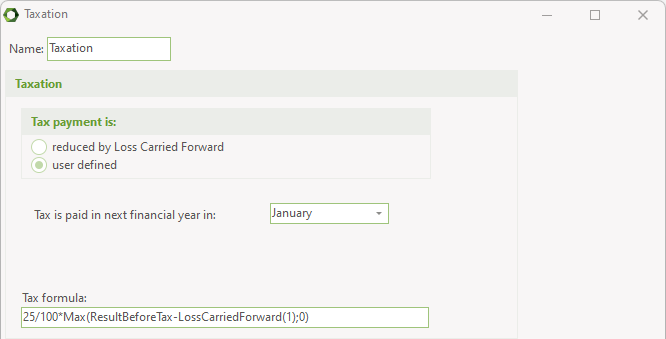Taxation
You can add one or more taxations to a project just as with investments or financing. You can e.g. build up taxation, which consists of among other a tax payment to the state and a tax payment to the county.
Tax is assumed to be paid once a year in a given month in the following fiscal year.
Tax payment is reduced by Loss Carried Forward
In this standard situation, you can turn into account the loss from a number of previous years. Specify the tax rate and the number of years from which you can utilize eventual losses.

Remark the window “Tax formula” in which you can see the actual formula corresponding to the specified data. The window is grey and inaccessible unless you select “User defined”.
Tax payment is User Defined
If you have selected “User defined” in the window “Tax payment” you get access to the formula window.

In the formula, you can use standard expressions and functions as Min, Max and Exp etc. In addition, you can use one of the special built-in functions listed below.
| Name | Returns |
|---|---|
| ResultBeforeTax | The result of the actual fiscal year before tax |
| LossCarriedForward(n) | The last n years loss reduced with eventually profits from the fiscal years |
| Increment(amount;n1;n2) | This function increments from zero with the value "amount" from fiscal year n1 to n2. Example: Increment(10,2,4) gives the result Fiscal year 1 : 0 Fiscal year 2 : 10 Fiscal year 3 : 20 Fiscal year 4 : 30 Fiscal year 5 : 30 |
| Year(n) | 1 in the fiscal year n, 0 otherwise Example: Year(1) + Year(2) returns 1 in the first and second fiscal year , otherwise it returns 0 |
Examples
Example 1
Standard situation with 30 % tax and the right to make use of losses from the three previous years:
Formula:
Example 2
If the company is a department of a larger company, the larger company can use a negative result from the department to reduce the tax. In this case, the tax will be paid into the department in years with negative result.
Formula
Example 3
The tax percentage starts with 30.0 and increase with 1 from the second fiscal year and over the next 4 years:
Formula:
Example 4
The project is tax-free the first two years and hereafter the tax percentage is 30 %: